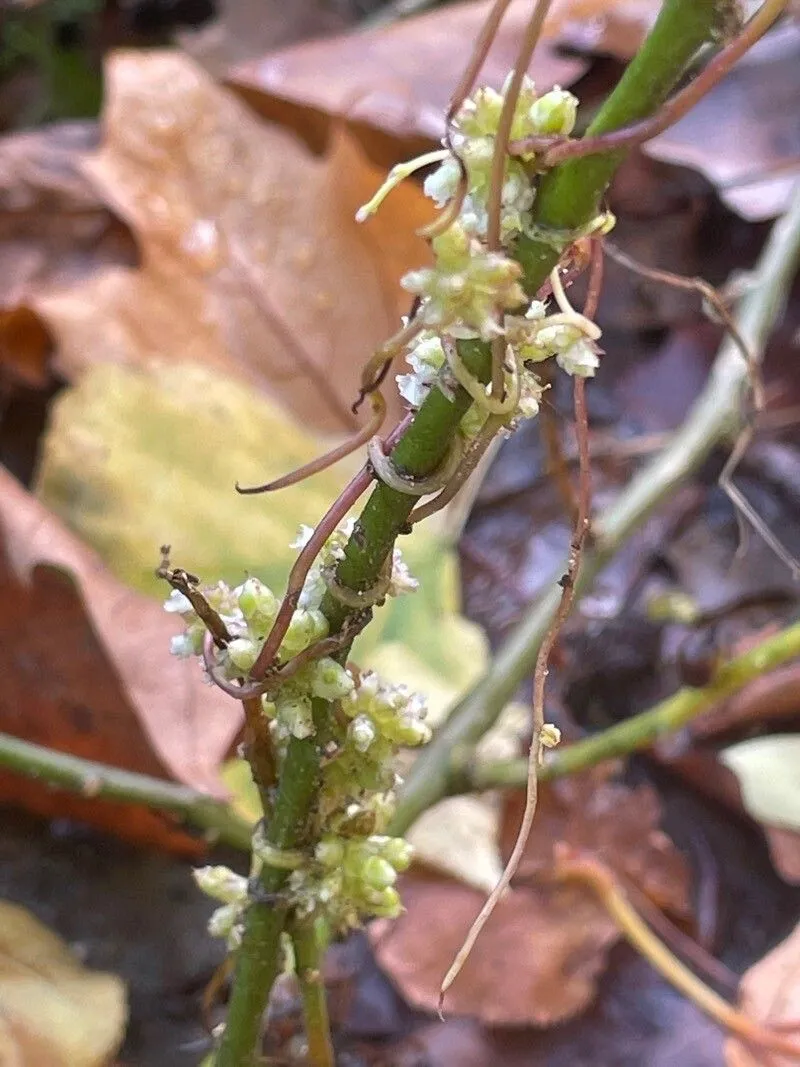
Author: L.
Bibliography: Sp. Pl.: 124 (1753)
Year: 1753
Status: accepted
Rank: species
Genus: Cuscuta
Vegetable: False
Observations: Temp. Eurasia to N. India
The European dodder, known scientifically as Cuscuta europaea, is a fascinating parasitic plant from the family Convolvulaceae. It was first described in 1753 by the renowned botanist Carl Linnaeus in his seminal work “Species Plantarum.”
Native to temperate regions of Eurasia extending to northern India, this intriguing plant lacks the ability to photosynthesize independently, relying instead on its host plants for sustenance. The European dodder attaches itself to the stems and leaves of various host plants using specialized structures known as haustoria. Through these haustoria, it extracts water and nutrients, allowing it to grow and reproduce without the need for traditional roots.
One of the most distinguishing features of the European dodder is its thin, yellowish or reddish stems, which can form complex tangles around its host plants. The absence of chlorophyll gives its stems their characteristic color. It produces small, clustered flowers that are generally white to pinkish in color, contributing to its unique appearance among other plant species.
This parasitic plant can have significant impacts on agriculture and horticulture because of its dependency on other plants for survival. It can weaken or even kill its hosts, leading to reduced yields in crops or damaged ornamental plants. Understanding the biology and ecological role of the European dodder is therefore crucial for managing its presence in both natural and cultivated environments.
The European dodder serves as a remarkable example of parasitism in the plant kingdom, highlighting the diverse strategies that plants have evolved to survive and reproduce in various environments.
Eng: european dodder, greater dodder, great dodder
Deu: europäische seide, nessel-seide, nessel-seide i.w.s., nesselseide
Dan: nælde-silke
Swe: euroopanvieras, nässelsnärja, nässelsilke, snarreva
Fin: euroopanvieras
Fra: grande cuscute
Nld: groot warkruid
Nor: liin-silke, liinskorv
Nno: snikjetråd
Nob: snyltetråd
Cym: cwlwm y coed, cwlwm y gwydd, cyfnydd, llinclwm mwyaf, llindag mawr, llindag mwyaf, llindro mwyaf
En: European dodder, Greater dodder, Great Dodder, Common Dodder, Scaldweed
Sq: Kuskuta evropiane
Ar: حامول أوروبي
Az: Avropa qızılsarmaşığı
Be: Павітуха еўрапейская
Bg: Кукувича прежда
Zh: 欧洲菟丝子
Hr: Europska vilina kosa
Cs: Kokotice evropská
Da: Nælde-silke
Nl: Groot warkruid
Et: Harilik võrm
Fi: Euroopanvieras, Humalanvieras
Fr: Cuscute d’Europe, Grande cuscute, Cuscute d’Europe
De: Europäische Seide, Nessel-Seide, Nesselseide, Nessel-Seide i.w.S.
It: Cuscuta europea
Lv: Eiropas vija
Lt: Paprastasis brantas
No: Neslenyltetråd, Neslesnikjetråd, Liin-silke, Liinskorv
Nb: Snyltetråd
Nn: Snikjetråd
Fa: سس اروپایی
Pl: Kanianka pospolita
Ru: Повилика европейская
Sk: Kukučina európska
Es: Cuscuta
Sv: Nässelsnärja, Euroopanvieras, Nässelsilke, Snarreva
Ta: கஸ்குட்டா யூரோப்பியா
Uk: Повитиця європейська
Cy: Llindag mawr, Cwlwm y Coed, Cwlwm y Gwydd, Cyfnydd, Llinclwm Mwyaf, Llindag Mwyaf, Llindro Mwyaf
Taken Oct 5, 2019 by Llandrich anna (cc-by-sa)
Taken Jul 16, 2019 by Llandrich anna (cc-by-sa)
Taken Jul 16, 2019 by Llandrich anna (cc-by-sa)
Taken Jul 16, 2022 by Sara (cc-by-sa)
Taken Jul 30, 2020 by Hans van den Heuvel (cc-by-sa)
Taken Jul 15, 2013 by Photoflora – Jean-Luc TASSET (©)
Taken Jul 30, 2015 by EOL − Donald Hobern (cc-by)
Taken Jul 30, 2015 by EOL − Donald Hobern (cc-by)
Taken Oct 5, 2019 by Llandrich anna (cc-by-sa)
Taken Oct 26, 2022 by David Hocken (cc-by-sa)
Taken Oct 30, 2018 by Llandrich anna (cc-by-sa)
Taken Oct 30, 2018 by Llandrich anna (cc-by-sa)
Taken Oct 3, 2022 by David Hocken (cc-by-sa)
Taken Oct 26, 2022 by David Hocken (cc-by-sa)
Taken Oct 26, 2022 by David Hocken (cc-by-sa)
Taken Jun 28, 2021 by Grishina Ksenia (cc-by-sa)
Taken Sep 24, 2022 by David Hocken (cc-by-sa)
Taken Jul 30, 2022 by Dario Rothauer (cc-by-sa)
Taken Jul 3, 2021 by sral lars (cc-by-sa)
Taken Aug 7, 2019 by Gianluca Comba (cc-by-sa)
© copyright of the Board of Trustees of the Royal Botanic Gardens, Kew.
© copyright of the Board of Trustees of the Royal Botanic Gardens, Kew.
© copyright of the Board of Trustees of the Royal Botanic Gardens, Kew.
Taken Aug 2, 2022 by Llandrich anna (cc-by-sa)
Taken Mar 3, 2016 by EOL − HermannFalkner/sokol (cc-by-nc-sa)
Taken Aug 15, 2018 by Jonas Bremer (cc-by-sa)
Taken Aug 15, 2007 by Photoflora – Jean-Luc TASSET (©)
Taken Oct 5, 2019 by Llandrich anna (cc-by-sa)
Taken Jan 1, 1970 by Photoflora – L’Abbé COSTE (©)
Taken Jan 1, 1800 by Tela Botanica − Daniel MATHIEU (cc-by-sa)
Taken Aug 15, 1987 by Photoflora – Jean-Luc TASSET (©)
Taken Aug 15, 2009 by Photoflora – Benoit BOCK (©)
Taken Jun 14, 2013 by Tela Botanica − Daniel CAHEN (cc-by-sa)
Growth habit: Forb/herb, Vine
Ph maximum: 7.5
Ph minimum: 7.0
Light: 8
Atmospheric humidity: 7
Bloom months: [‘jun’, ‘jul’, ‘aug’, ‘sep’]
Soil nutriments: 8
Family: Myrtaceae Author: (F.Muell.) K.D.Hill & L.A.S.Johnson Bibliography: Telopea 6: 402 (1995) Year: 1995 Status:…
Family: Rubiaceae Author: Pierre ex A.Froehner Bibliography: Notizbl. Bot. Gart. Berlin-Dahlem 1: 237 (1897) Year:…
Family: Sapindaceae Author: Koidz. Bibliography: J. Coll. Sci. Imp. Univ. Tokyo 32(1): 38 (1911) Year:…
Family: Asteraceae Author: A.Gray Bibliography: Pacif. Railr. Rep.: 107 (1857) Year: 1857 Status: accepted Rank:…
Family: Fabaceae Author: Medik. Bibliography: Vorles. Churpfälz. Phys.-Ökon. Ges. 2: 398 (1787) Year: 1787 Status:…
Family: Aspleniaceae Author: (Cav.) Alston Bibliography: Bull. Misc. Inform. Kew 1932: 309 (1932) Year: 1932…